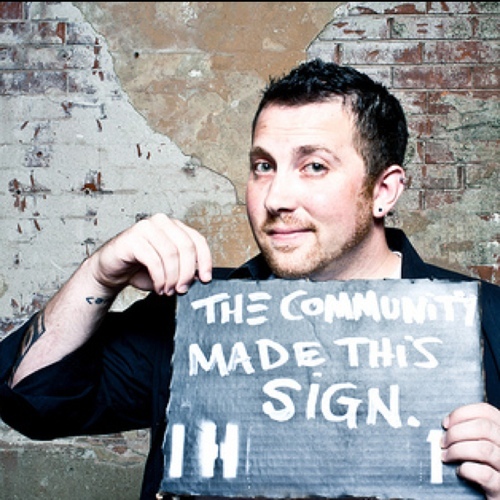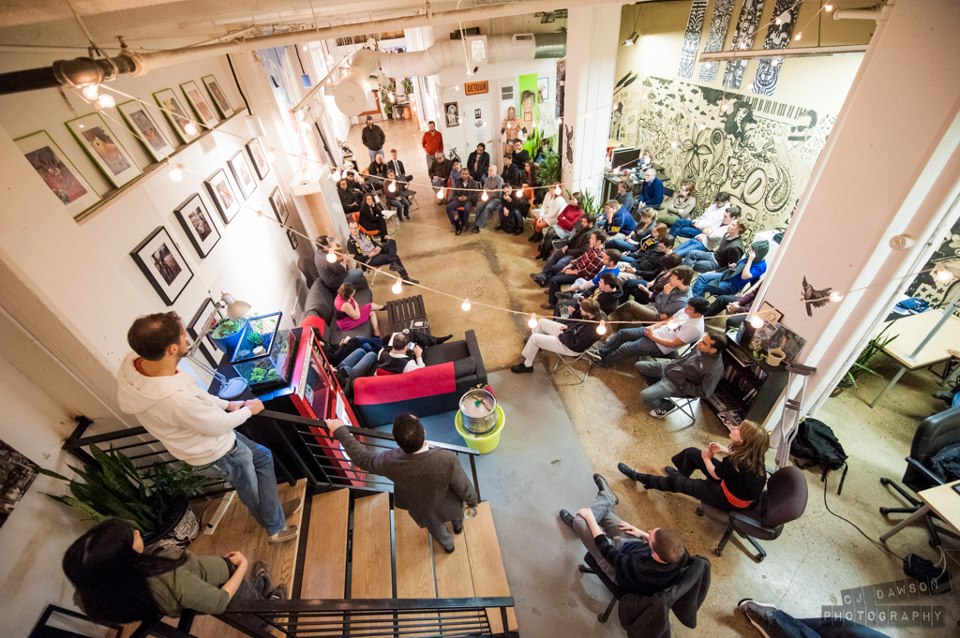Alex Hillman on Transforming your City: Stop waiting for someone else to do it!
Lately I’ve been hearing a lot of conversations around New Bedford about the failed casino project and how this city “can’t seem to catch a break.” And while the casino would have cleaned up a big waterfront site and created some jobs, I’d like to shift the conversation towards other ways that we ourselves can make this city a better place to live and work.
To accomplish this I called upon Alex Hillman, co-founder of Indy Hall, a thriving coworking community in Philadelphia. Alex’s blog and writings about the importance of community inspired us to start Groundwork! here in New Bedford.
Indy Hall has made huge contributions to its neighborhood, Old City, and to making Philadelphia better place to live, and Alex was kind enough to answer my questions about his work and experience in Philly. What follows is an important message for all of us who care about the future of New Bedford:
What was the Old City neighborhood like when you decided to open Indy Hall?
When we opened in 2007, Old City was known for three things:
- Flocks of tourists in the summer (we’re a few blocks from the Liberty Bell and Independence Hall)
- Art gallery openings on the First Friday of every month
- The weekend bar scene
Of all of the things it was, a “hotbed of creative professionals” wasn’t one of them.
What attracted you to that particular neighborhood?
I wrote about this in a recent post about different conversations I’ve been having with people about the future of Indy Hall:
When we surveyed our original community for founding members, we learned that most of our members were in Northern Liberties, South Philly, and West Philly. I’m pretty sure an updated survey would show that’s still pretty accurate, expanding Northern Liberties into Fishtown & Kensington.
So naturally, we looked at potential spaces in all of those neighborhoods.
And some were pretty cool…but were a real pain to get to. That’s where we realized that if we picked any one of those neighborhoods to get started in, there’s a good chance that people from the other parts of the city would be less likely to make the trip.
So we started looking at Old City. Not because it was a hotspot for creative businesses, but specifically because it wasn’t one of the parts of Philadelphia where most of our members were. There were a couple of important creative business anchors – notably Weblinc and I-Site who predated us – but the odds of running into familiar faces the way you can in today’s Old City was completely foreign.
At the same time, we found that it felt easy to jump on a bus, subway, or bicycle from just about anywhere in the city and be there in 10-15 mins. Less convenient for our friends traveling in from the suburbs, but that’s never been our strength.
IN A WAY, OLD CITY WON IN OUR SEARCH BECAUSE IT WAS THE UN-NEIGHBORHOOD.
And I don’t mean that to be diminutively.
Because as Old City has changed, we’ve gotten to grow up along with it. We’ve gotten to become a part of a story that’s been in motion for decades or longer. We’ve been able to enjoy the explosion of amazing restaurant and bar scene. The “campus” feel of Old City has become a huge draw, making it easy to bump into friends almost anywhere in the neighborhood…and not just at National Mechanics.
What are the biggest changes you’ve seen in the area since you opened?
For the last couple of years, Indy Hall Arts has gotten to play a role in the art community, attracting thousands of attendees and many first-time art buyers to our First Friday shows. Through the N3rd St Farmers Market, I’ve met more of our neighbors in the last 2.5 years than I did in the previous 6. And I don’t have to say how awesome it is to have places like Spruce Street Harbor Park and Independence Beer Garden within easy walking distance as a way to enjoy each others’ company outside.
And then there’s the graduates:
When Indy Hall members’ grow their companies larger than 3-4 people, they almost universally begin looking for ways to stay in the neighborhood. Within a two block radius of Indy Hall, at least 100 people are employed by Indy Hall alum.
And we’ve gotten to play a role in dozens of businesses choosing to open their first and second offices in Old City, and many more expand into the neighborhood. We’ve even had a steady stream of companies occupy our former coworking space on Strawberry Street.
Today, Old City is a destination for a lot more than tourists and bar-hoppers, and I’m really proud of that. But maybe most importantly to myself and for many of our members, Old City has a sense of “home” for us.
Old City is now one of the art hubs in Philly; can you connect that to movements that came out of the Indy Hall community?
I want to be clear, Old City has LONG been a hub for the arts; long, long, long before Indy Hall. In fact my business partner was part of starting an art collective here decades ago.
The connection between art & Indy Hall really started to galvanize when we expanded to include a ground floor with a street entrance, because we were able to use our entrance way as an art gallery. First Fridays were already happening, we just had a way to participate in them differently than we ever had before.
But our art program runs on the same ethos and core values as our coworking community. The art shown is by members and friends of members. The shows are staffed by members. It’s just like any other community effort for us.
It seems like Indy Hall is much more than “coworking,” I know that you have an art gallery and you also host farmers’ markets. Can you comment on how the coworking movement spills out into other aspects of community building?
Stop thinking about coworking as workspace. Instead, think about it as a laboratory and a classroom where people can learn how to work better, and often, work together. It all stems from a basic pattern of prioritizing relationships before transaction. That choice and intention results in a different better way of getting work done.
When you think about it that way, you start to realize we’re barely scratching the surface with “collaborative workspaces” and there’s COUNTLESS ways to apply that pattern to nearly everything.
Have you noticed your members taking a more active role in the neighborhood as a result of their experience at Indy Hall?
Yep, absolutely. Membership isn’t just a synonym for renter without a lease. Membership is more like citizenship. If you want the community to be better, you need to play an active role in it.
Jennifer Pahlka, the founder of Code for America, once asked me “how do members of Indy Hall think about the City? Like, capital-C city, City Hall?” I wasn’t sure how to answer because frankly, I wasn’t sure how I thought about the City in those terms.
But I realized something. Indy Hall’s ambition is to make Philadelphia a better place to make a living doing what we love and every decision we make and action we take is aligned with that. Indy Hall is designed to be a good citizen of Philadelphia.
And because we put so much work into helping our members be good citizens of Indy Hall…by transitive property, they’re good citizens of Philadelphia. This is a powerful way of thinking about citizenship, where an EXTREMELY local focus is actually designed to serve a wider audience than meets the eye.
A lot of people think that our city, New Bedford, can’t catch a break and is destined to stay in a slump. What advice do you have for those of us who are trying to change that perception and bring new life into the city?
The idea of “catching a break” is the problem. Stop waiting for someone to do it, and do it. Ignore the dissenters, just get the job done. Be consistent. Be intentional.
Invite people to join you, but don’t EXPECT them to.
A lot of the time, people won’t join in until they see momentum. Actions convince much more loudly than words.
In your opinion, what are the most important components that make up a great community and place to live?
You only need two things: neighbors who give a shit about each other, and places to gather in public/semi-public. Everything else is an outcome of having those two things.
***
I hope you are as inspired as I am, New Bedford! For more bits of community-building wisdom, check out Alex’s blog.
- Meet Our General Manager: Nicole Cosme - February 26, 2024
- Can I use a coworking space for Google My Business? - April 26, 2023
- Marketing Lab: The Best Business Resource on the South Coast You Didn’t Know About - March 23, 2023



